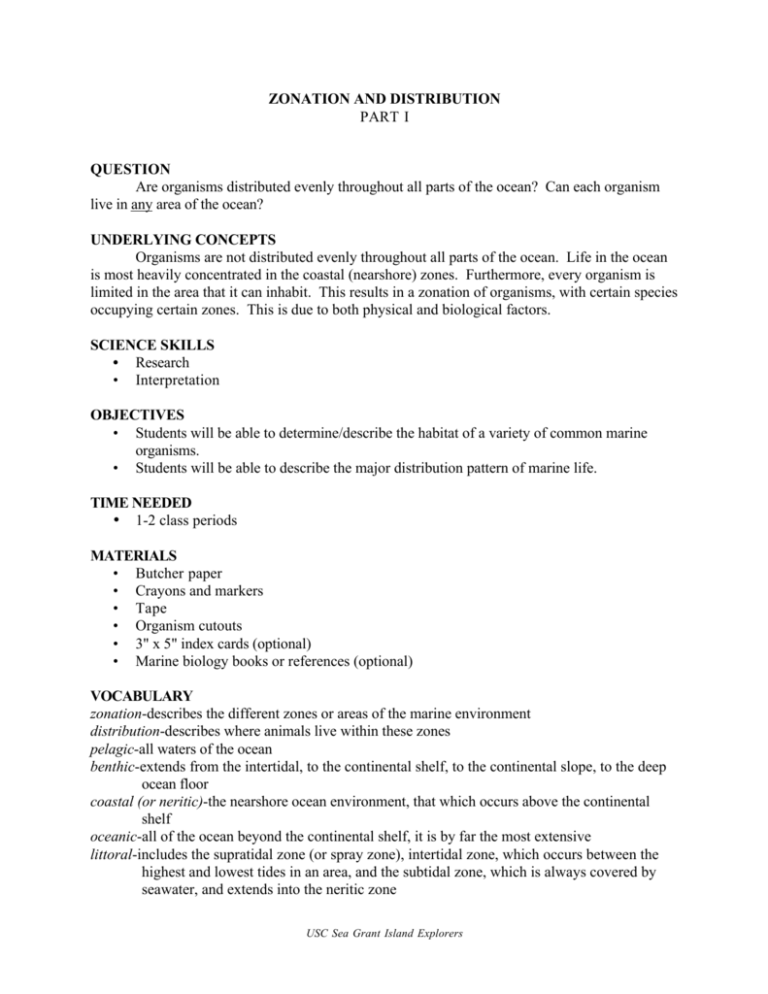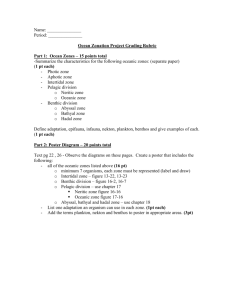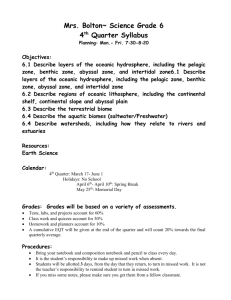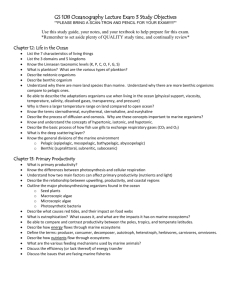Zonation and Distribution: Part 1
advertisement

ZONATION AND DISTRIBUTION PART I QUESTION Are organisms distributed evenly throughout all parts of the ocean? Can each organism live in any area of the ocean? UNDERLYING CONCEPTS Organisms are not distributed evenly throughout all parts of the ocean. Life in the ocean is most heavily concentrated in the coastal (nearshore) zones. Furthermore, every organism is limited in the area that it can inhabit. This results in a zonation of organisms, with certain species occupying certain zones. This is due to both physical and biological factors. SCIENCE SKILLS • Research • Interpretation OBJECTIVES • Students will be able to determine/describe the habitat of a variety of common marine organisms. • Students will be able to describe the major distribution pattern of marine life. TIME NEEDED • 1-2 class periods MATERIALS • Butcher paper • Crayons and markers • Tape • Organism cutouts • 3" x 5" index cards (optional) • Marine biology books or references (optional) VOCABULARY zonation-describes the different zones or areas of the marine environment distribution-describes where animals live within these zones pelagic-all waters of the ocean benthic-extends from the intertidal, to the continental shelf, to the continental slope, to the deep ocean floor coastal (or neritic)-the nearshore ocean environment, that which occurs above the continental shelf oceanic-all of the ocean beyond the continental shelf, it is by far the most extensive littoral-includes the supratidal zone (or spray zone), intertidal zone, which occurs between the highest and lowest tides in an area, and the subtidal zone, which is always covered by seawater, and extends into the neritic zone USC Sea Grant Island Explorers 2 BACKGROUND I. Distribution To describe relationships in the marine environment, we must be able to define where different groups of organisms live in the ocean. Marine ecologists have divided the ocean into two major zones: the pelagic zone includes all the waters of the ocean, and the benthic zone includes the ocean bottom. The pelagic zone is further divided into the littoral, neritic, and oceanic zones (Figure 1). The littoral zone includes the supratidal zone (or spray zone). The littoral zone also includes the intertidal zone, which occurs between the highest and lowest tides in an area. The final area of the littoral zone is the subtidal zone, which is always covered by seawater, and extends into the neritic zone. The neritic zone is the nearshore ocean environment, that which occurs above the continental shelf and is often called the coastal waters. The oceanic zone, by far the most extensive, is all the rest of the ocean beyond the continental shelf. The benthic zone extends from the intertidal, to the continental shelf, to the continental slope, to the deep ocean floor. The material that covers the ocean floor can range from mud or silt to large rocks. Life in the ocean is not evenly distributed. Organisms are much more abundant is nearshore waters than in oceanic waters. Scientists often use the term biomass to indicate the total mass of all organisms in an area. Biomass is usually given as grams/m2 or grams/m3. Although the oceanic zone comprises 90% of the ocean's area, the neritic zone has ~ 40 times more biomass than the oceanic zone. The greater abundance of biomass in coastal areas is due primarily to the abundance of phytoplankton in this zone. Phytoplankton are the basis of most food chains in the ocean; they are at the "bottom" of the food chain. Phytoplankton are more abundant closer to shore because there are more nutrients (inorganic molecules needed to survive) here. Most organisms live closer to shore because this is where most of the food is. II. Organisms in Groups Ecologists may study the interaction of one individual organism with its environment, but more often, they study the interactions within groups of organisms. Groups of organisms are organized into distinct levels: A population is a group of individuals of the same species living in a particular place. A community consists of all the populations (plants and animals) inhabiting a given area. An ecosystem includes all of the communities and their physical environment within a large geographical area. Ecosystems are very important in ecology because they convey the concept that all organisms are a part of a system of interacting biotic (living) and abiotic (not living) factors. A change in one species in an ecosystem will effect all other species in that system in one way or another. Ecosystems have specific characteristics: a. they have a source of energy, most often the sun b. they cycle nutrients between the abiotic and biotic environments c. they convert inorganic energy into organic molecules d. they regulate the flow of energy from organism to organism USC Sea Grant Island Explorers 3 Methods Using the butcher paper and large markers, make a map of the ocean floor like the one shown in Figure 2. Make sure that the map is large enough to paste many 3"x5" pictures of marine organisms about onto it. Discuss the major zones of the ocean and label them on your map. Hang your giant map at the front of the classroom. Hand out the organism cards to the students (2 per student for a class of 25). On the back of each card is a brief description of the animal and its habitat. Have each student come up to the front of the class and tape their organism onto the appropriate area of the map. Extensions 1) Students can research their organisms to find out the correct coloration, then color in the drawings with crayons or markers. 2) You may paste the organism cutouts onto index cards to cover up the description on the back. Then have the students research each organism to find out where it lives. This will require an extra class period and marine biology reference books. You may want to try one of the following: a. From the Sea to Shining Sea by; Amy L. Cahn b. Life Starts in the Sea by; Andrea Lamas c. One Small Square-Seashore by; Donald M. Silver d. The Complete Aquarium by; Peter W. Scott 3) Discuss the organization of organisms within groups and the concept of an ecosystem. USC Sea Grant Island Explorers HARBOR SEAL Coastal Mostly Pelagic HARBOR SEAL PLANKTON Pelagic Coastal and Oceanic Mostly Near Surface PLANKTON (zooplankton, phytoplankton) OWL LIMPET Coastal Mid to Upper Intertidal Rocky Shore OWL LIMPET ACORN BARNACLE Coastal Rocky Shore High to Low Intertidal Benthic ACORN BARNACLE FLYING FISH Oceanic Pelagic Shallow Water FLYING FISH SHEEPHEAD FISH Coastal Pelagic 30-60 Ft Deep (in kelp beds) SHEEPHEAD FISH BRITTLE STAR Coastal Rocky Shore Subtidal to 100 Ft Deep Benthic BRITTLE STAR MUSSEL Coastal Rocky Shore Mid Intertidal Benthic MUSSEL SENORITA FISH Coastal Pelagic 10-60 Ft Deep (Often in Kelp Beds) SENORITA FISH MORAY EEL Coastal Subtidal Shallow Water MORAY EEL MIDSHIPMEN Oceanic Deep Water (>3000 Meters) MIDSHIPMEN KEYHOLE LIMPET Coastal Low Intertidal to Subtidal Rocky Shore Benthic KEYHOLE LIMPET CANCER CRAB Coastal Rocky Shore Intertidal to 130 Ft Deep Benthic CANCER CRAB HATCHET FISH Oceanic Pelagic Deep Water (>3000 Meters) HATCHET FISH SARGO Coastal & Oceanic Pelagic SARGO FISH ANCHOVIES Mostly Coastal (Oceanic Sometimes) Pelagic ANCHOVIES MOON JELLY FISH Coastal Pelagic MOON JELLY FISH SEA STAR Coastal Rocky Shore Mid Intertidal to Subtidal Benthic SEA STAR ABALONE Coastal Subtidal to 500 Ft Deep Benthic ABALONE SCULPIN Benthic Subtidal 20-30 Ft Deep SCULPIN SEA HARE Coastal Low Intertidal to 60 Ft Deep Rocky Shore (Sheltered) Benthic SEA HARE RED STRIPED SHRIMP Mid to Low Tidal (tide pools) Rocky Shores RED STRIPED SHRIMP AGGREGATING ANEMONE Coastal Rocky Shore Mid Intertidal to Shallow Subtidal Benthic AGGREGATING ANEMONE GIANT KELP Coastal Rocky Bottom Subtidal 20-1000 Ft Deep Benthic GIANT KEP GREY WHALE Coastal and Oceanic Pelagic Shallow to Very Deep GRAY WHALE SEA LION Coastal Pelagic and Benthich Rocky Shores SEA LION GREAT WHITE SHARK Coastal and Oceanic Pealic Shallow to Very Deep GREAT WHITE SHARK FEATHER BOA KELP Coastal Rocky Shore Mid-Intertidal Benthic FEATHER BOA KELP LEOPARD SHARK Coastal Subtidal Sandy Bottoms Mostly Benthic LEOPARD SHARK SQUID Coastal and Oceanic Pelagic Shallow to Very Deep SQUID CORALLINE RED ALGAE Coastal Rocky Shore Mid Intertidal to > 50 Ft Deep Benthic CORALLINE RED ALGAE SEA URCHIN Coastal Rocky Shores Low Intertidal to 500 Ft Deep Benthic SEA URCHIN Copy Organism pages and cut along gray outline. When each Organism is cut out, fold in half to create a “flash card” with picture on one side and information on reverse.







